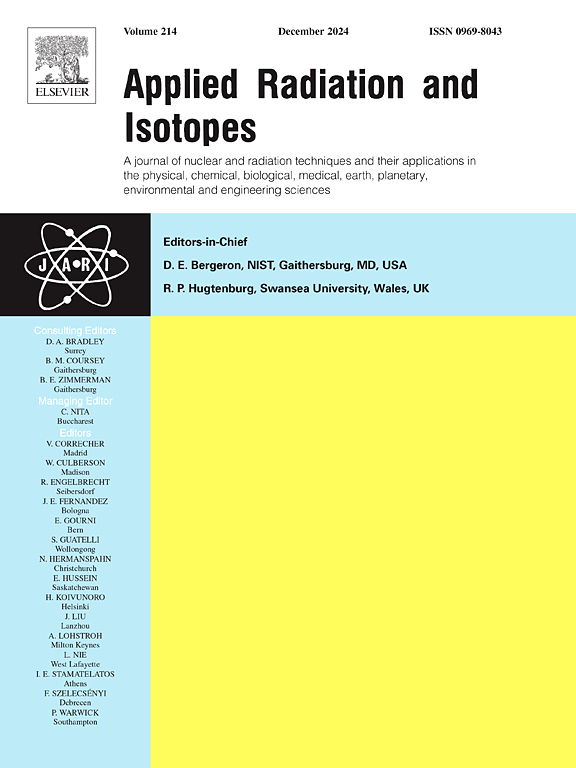伽马射线诱导通过体外诱变获得的甘蔗变异体显著的表型和代谢物变化。
IF 1.8
3区 工程技术
Q3 CHEMISTRY, INORGANIC & NUCLEAR
引用次数: 0
摘要
甘蔗是一种具有重要经济价值的多倍体作物,其遗传复杂性和有限的肥力对作物改良计划提出了挑战。伽马辐射诱变是产生多种农艺学上有用的突变体的另一种方法,可以加速甘蔗等长期作物的品种发育。为获得具有农艺价值的商业甘蔗co99004基因型突变体,对其进行了体外诱变研究。co99004 V1代表型变异可分为5个不同的表型可评分类,包括3个叶绿素突变体(白化、氯化和氯化色素)和2个绿色突变体(如野生型对照)。SRAP标记分析表明,表型突变体和对照植株之间存在明显的基因组差异,多态性信息含量(PIC)在0 ~ 0.472之间。此外,基于SRAP标记数据的系统发育树状图将突变体分为四个不同的簇,明确区分了表型分类。选定的SRAP扩增子测序显示基因特异性片段的缺失/插入。有趣的是,在白化病和氯化病突变体中,叶绿素的丢失显示出伽马辐射诱导的编码far1相关序列5样蛋白的基因缺失,该基因参与叶绿素的生物合成。基于GC-MS的代谢组分析显示,四吡啶生物合成、甲基赤藓糖醇磷酸(MEP)和脂肪酸生物合成途径发生了改变,表明叶绿素突变体的代谢发生了显著变化。进一步鉴定遗传上不同的、非致死的绿色野生型突变体可以鉴定出农艺学上有用的突变体。此外,丧失功能的叶绿素突变体可以作为比较基因组学研究的一个很好的来源,旨在研究基因-性状关联。本文章由计算机程序翻译,如有差异,请以英文原文为准。
Gamma ray induced significant phenotypic and metabolite changes in sugarcane variants derived through in vitro mutagenesis
Sugarcane is an economically important polyploid crop whose genetic complexity and limited fertility poses a challenge for crop improvement programs. Gamma radiation-induced mutagenesis is an alternate approach for generating a diverse array of agronomically useful mutants, accelerating varietal development in a long-duration crop like sugarcane. To develop agronomically useful mutants of a commercial sugarcane genotype Co 99004, gamma ray induced in vitro mutagenesis was carried out. The phenotypic variants of Co 99004 in V1 generation could be categorized into five distinct phenotypically scorable classes, including three chlorophyll mutants (albina, chlorina and chlorina pigmented) and two green mutants like wild type control. SRAP marker analyses indicated distinct genomic variation among the phenotypic mutants and control plants, with the polymorphic information content (PIC) ranging from 0 to 0.472. Further, the phylogenetic dendrogram derived from the SRAP marker data grouped the mutants into four distinct clusters clearly differentiating the phenotypic classification. Sequencing of selected SRAP amplicons indicated deletion/insertion of gene specific fragments. Interestingly, the loss of chlorophyll in albina and chlorina mutants showed gamma irradiation-induced deletions in the gene encoding FAR1-RELATED SEQUENCE 5-like protein, which is involved in chlorophyll biosynthesis. GC-MS based metabolome profiling showed alteration in tetrapyrrole biosynthesis, MEP (Methylerythritol Phosphate), and fatty acid biosynthesis pathways, indicating a significant metabolic variation in the chlorophyll mutants. Further characterization of the genetically distinct, non-lethal green wild type mutants can lead to the identification of agronomically useful mutants. In addition, the loss-of-function chlorophyll mutants can serve as a good source for comparative genomics studies aimed at gene-trait association.
求助全文
通过发布文献求助,成功后即可免费获取论文全文。
去求助
来源期刊

Applied Radiation and Isotopes
工程技术-核科学技术
CiteScore
3.00
自引率
12.50%
发文量
406
审稿时长
13.5 months
期刊介绍:
Applied Radiation and Isotopes provides a high quality medium for the publication of substantial, original and scientific and technological papers on the development and peaceful application of nuclear, radiation and radionuclide techniques in chemistry, physics, biochemistry, biology, medicine, security, engineering and in the earth, planetary and environmental sciences, all including dosimetry. Nuclear techniques are defined in the broadest sense and both experimental and theoretical papers are welcome. They include the development and use of α- and β-particles, X-rays and γ-rays, neutrons and other nuclear particles and radiations from all sources, including radionuclides, synchrotron sources, cyclotrons and reactors and from the natural environment.
The journal aims to publish papers with significance to an international audience, containing substantial novelty and scientific impact. The Editors reserve the rights to reject, with or without external review, papers that do not meet these criteria.
Papers dealing with radiation processing, i.e., where radiation is used to bring about a biological, chemical or physical change in a material, should be directed to our sister journal Radiation Physics and Chemistry.
 求助内容:
求助内容: 应助结果提醒方式:
应助结果提醒方式:


